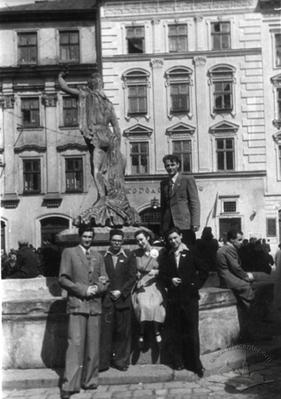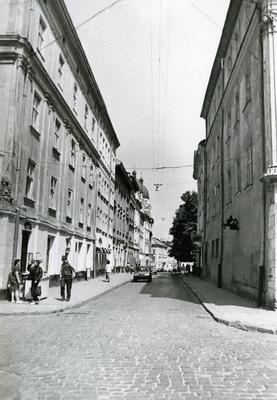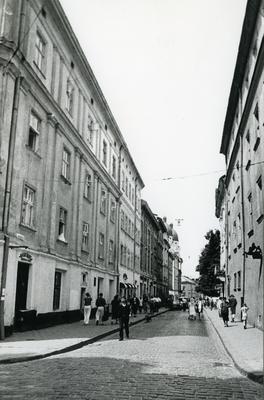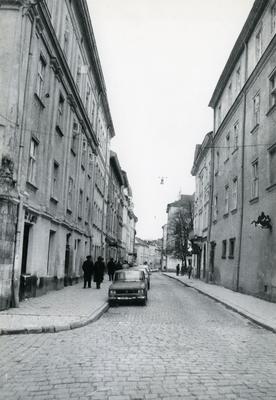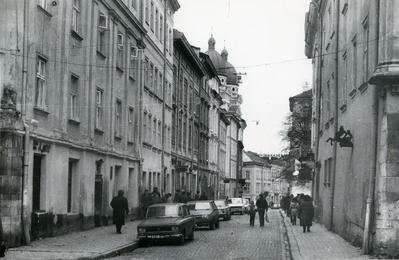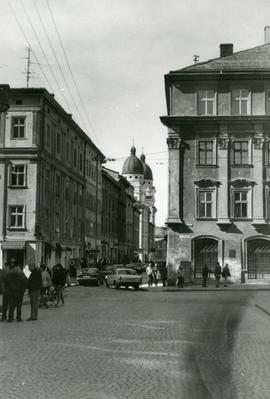Vul. Krakivska, 2 – former Kilianishchynska/Kiljaniszczyńska townhouse ID: 2020
Story
The first mention in historical documents of the stone manor building on the corner of Market Square and Krakivska Street dates from the 1630s, when it belonged to the Łonczycz merchant clan. In 1637 the building was bought by the pharmacist Jan Kilianistа and has since that time been known as the Kilianishchinska building (also, Klinianshchinska).
During the 18th century the building was briefly known as the Zemianska Manor (also, Zemlianska or Zemska) because it was owned by the Lviv Zemstvo, the union of the local gentry. In 1744, the Zemstvo commissioned architect Bernard Meretyn to reconstruct the building. It would again undergo reconstruction in 1776 on a design by Franciszek Kulczycki. In 1860, a fourth floor was added to the structure, and in 1881 the staircase was updated with the addition of interior lighting.
A café has occupied the structure’s ground floor since the 19th century. During the Soviet era it was known as “At the Market” but a figure on the Krakivska Street façade led to the popular moniker of “the Centaurs”. In the early years of this century, a restaurant remodeling project added an entrance from the Krakivska Street side as well. The premises are currently occupied by a bank. The Kilianishchivska building was registered as national architectural monument of urban development as decreed by the Ukrainian Soviet Republic Council of Ministers, 24 August 1963, Decree № 970, 326/28.
Architecture
The Kilianishchivska building occupies a corner where Market Square meets Krakivska Street (its alternate address is 33 Market Square). It is a brick four storey rectangular construction with continuous stone foundation. It received its contemporary structure and façade compositions during its 18th century reconstruction. A stone buttress fortifies the corner of the structure. The original entrance – later an entrance into a coffee-shop – was oriented on Market Square. The staircase entered from Krakivska Street. The ground floor walls are built of quarried stone, with arcuated lintels around the shop windows and portal. The ancient ribbed vaults of the ‘beer cellar’ and ground floor have been preserved.
The Market Square façade has a pronounced character, with second and third story walls are visually divided by pilasters of the Composite Order with richly ornamented capitals bearing up a profiled cornice. Windows are framed with white stone. The second floor windows are accented with garlanded baroque window cornices to balance the vertical façade composition. In the mid-19th century, an additional, truncated fourth floor in a late-Baroque style was added above the existing cornice.
The Krakivska Street façade is austere and laconic. The windows are framed modestly, the walls smooth, devoid of decoration elements.
Architectural ensemble of Bernard Meretyn’s Kilianishchivska building serves as a characteristic example of a Baroque reconstruction of a Renaissance building.
People
Łonczycz
– merchant family,
manorowner
Jan
Kilianistа – pharmacist,
manorowner
Franciszek
Ksawery Kulczycki – architect
Bernard
Meretyn (Merderer,
Meretini) – architect
Sources
- Bevz, M., et al. “Baroque Architecture (17th-18th centuries).” Architecture of Lviv: Times and Styles, 13th-21st centuries. Lviv: Center of Europe Publishing, 2008. pp. 120-169.
- Catalogue of 17th-20th Century Engraving from the V. Stephanyk Lviv Research Library Foundation of the Ukrainian SSR. Kyiv: Naukova Dumka, 1989.
- Charewiczowa Ł. Czarna kamienica i jej mieszkańcy: Z 33 ilustracjamiwtekscie (The Black Manor and its Inhabitants, with 33 illustrations). Lwów, 1935; reprint 1990.
- Kapral, M. Native Assemblies in Lviv of the 16th-18th centuries (civil and legal interrelations) Lviv: Piramida, 2003.
- Melnyk, B. On the Streets of Old Lviv. Lviv: Svit, 2001.
- Vuitsyk, V. The State Historical Landmark Preserve in Lviv. Lviv: Kamenyar, 1991.












